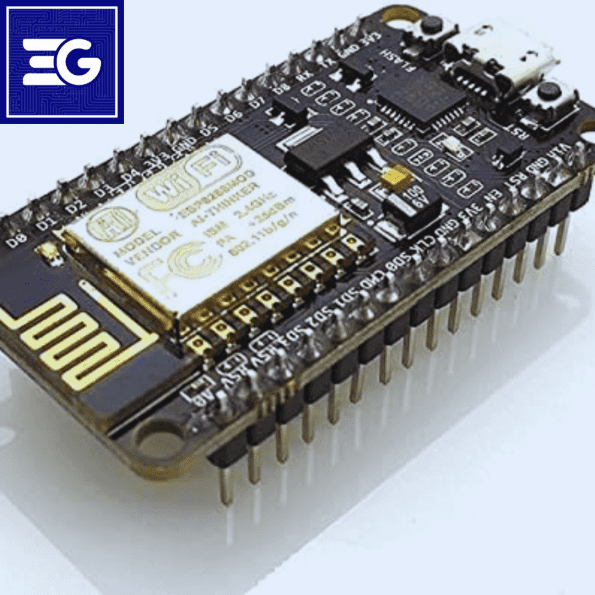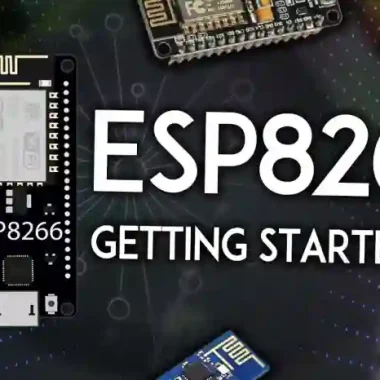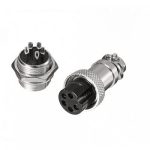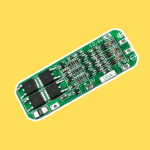INTRODUCTION
NodeMCU has proven to be a very popular and powerful development platform in the ever growing world of the Internet of Things (IoT). With its great ease of use and versatility, it has found itself in use among DIY folks, hobbyists, and even professionals. On combining NodeMCU and the ESP8266 module, it offers an endless scope for making smart, connected devices. But what exactly is NodeMCU?
“If you find yourself wondering what is NodeMCU?” you’ll find out that it’s an open source IoT platform based on the ESP8266 Wi-Fi chip, enabling you to design low cost IoT applications.” Combined, this is a powerful duo which enables you to build Arduino and ESP8266 projects with ease.
What is NodeMCU?
Essentially, it is a development board containing an ESP8266 chip, with GPIO pins and a USB interface, capable of running Lua or Arduino based code. The main goal of NodeMCU is to make the overall IoT development process, which includes wi-fi connect, data collect, and machine to machine communicate, as simplified as possible.
The ESP8266 chips themselves are, of course, available, but NodeMCU maintains an easy to use and popular module, which has the addition of everything you’ll need already packaged within the module.

What makes NodeMCU the perfect choice for developing Hardware?
Here are seven compelling reasons why using NodeMCU is a game-changer for building Arduino and ESP8266 based IoT projects:
1. Simple ESP8266 Integration
At its root, what makes NodeMCU so robust for connectivity is the very fact that it is built around ESP8266 Wi-Fi module. Developers can take advantage of ESP8266 with minimal wiring, no separate breakout boards required. There is a deep relationship with the ESP8266 chip, so the common question, “NodeMCU what is?” is no surprise.
2. Comprehensive ESP8266 Pinout
This means that it is important to understand NodeMCU ESP8266 pinout. NodeMCU includes clear GPIO labels which makes it easier to interface with external components such as sensors, LEDs, relays and more. Working with NodeMCU chip board allows us to easily identify which pins are which so we can quickly connect the right pins with very little confusion. This is a big plus over bare ESP8266 boards that must all be handled with external wiring and pin configuration considerations.
3. Compatibility with Arduino
NodeMCU will make your the transition easier if you know Arduino boards and the Arduino IDE. It comes fully compatible with Arduino and ESP8266 environments: developers can write and upload code with Arduino IDE. In fact, compatibility with beginners is crucial: the goal is to make use of what you know, what you have, and what you already sketched without having to learn a new development environment.
4. Effortless Wi-Fi Connectivity
The ESP8266 chip gives NodeMCU built-in Wi-Fi capabilities, and is one of the most powerful features of NodeMCU. To spare costs of additional Wi-Fi modules or shields, using NodeMCU for its wireless communication is better off the shelf. Given that this is a mature standard, it is therefore a perfect choice for IoT projects where seamless and reliable connectivity is a must have. NodeMCU can do practically anything: from smart home devices to weather stations.
5. Or support for Lua and Arduino Code
Lua scripting and the Arduino code environment are both supported by NodeMCU’s firmware. If you’re looking for a lightweight and flexible scripting language, then Lua scripting is your choice. But if you feel more comfortable around Arduino IDE, the drag and drop NodeMCU compatibility makes this very easy to code in a familiar fashion.
6. Regardless of what projects are actually reviewed, the broad community and open source support surrounding your application can be difficult to duplicate.
Being open source, NodeMCU has quickly attracted a large community of developers and enthusiasts. You also have an active community so there are a lot of resources, tutorials and forums to start with. If you can’t get ESP8266 pinout, can’t connect with Wi-Fi or faced problem with coding, here you can easily ask someone who already stand in your shoes before.
7. Cost-Effective and Versatile
Finally, NodeMCU is very budget friendly against other development platforms. At a cost effective price it combines the processing power, memory and Wi-Fi capabilities in one package. This cost effectiveness renders NodeMCU to be an excellent choice for those looking to protoype and deploy small scale IoT projects without blowing up the bank.
In this tutorial we will explain to you NodeMCU ESP8266 pinout.
Before we start working with NodeMCU, it’s good to know its ESP8266 pinout to know what to connect where. NodeMCU provides 17 GPIO pins clearly labeled for the purpose of UART, PWM, I2C, SPI, and others. Here’s a breakdown of the critical pins and their purposes:
GPIO0 to GPIO15: Fundamentally, these general purpose I/O are inputs or outputs which can be used in many different tasks. For example, GPIO2 is associated to an onboard LED, and can be used for status indication.
ADC (A0): NodeMCU has a single analog input pin with 10 bit resolution. This pin is able to read in voltages between 0 to 1V, so you can plug analog sensors like a potentiometer, temperature sensor etc, or LDRs into it.
RX and TX: These pins are for serial communication with a microcontroller or an external devise. It is crucial when you upload the code via Arduino IDE.
What is needed in order to program NodeMCU with Arduino IDE?
It is easy to program NodeMCU with Arduino IDE. There is nothing to do, just install ESP8266 board definitions and necessary libraries. NodeMCU has this flexibility of bridging the gap between Arduino and ESP8266, that’s why it is the perfect combination of both platforms from the developers perspective.
Understanding NodeMCU ESP8266 Pinout
When working with NodeMCU, understanding its ESP8266 pinout is vital for making connections. NodeMCU offers 17 GPIO pins labeled clearly for various functions, including UART, PWM, I2C, and SPI. Here’s a breakdown of the critical pins and their purposes:
-
- GPIO0 to GPIO15: These general-purpose I/O pins can be used as inputs or outputs, making them versatile for various tasks. For example, GPIO2 is connected to an onboard LED, which can be utilized for status indication.
-
- ADC (A0): NodeMCU includes a single analog input pin with a 10-bit resolution. This pin can read voltages between 0 and 1V, making it ideal for interfacing analog sensors such as potentiometers, temperature sensors, or LDRs.
-
- RX and TX: These pins are used for serial communication with the microcontroller or other external devices. They are crucial when uploading code through the Arduino IDE.
How to Program NodeMCU with Arduino IDE
Programming NodeMCU with the Arduino IDE is simple and straightforward. All you need to do is install the ESP8266 board definitions and the necessary libraries. This flexibility allows developers to bridge the gap between Arduino and ESP8266, using NodeMCU as a perfect combination of both platforms.
Here’s a simple example of a code snippet to connect NodeMCU to Wi-Fi:
#include <ESP8266WiFi.h>
const char* ssid = "Your_SSID";
const char* password = "Your_Password";
void setup() {
Serial.begin(115200);
WiFi.begin(ssid, password);
while (WiFi.status() != WL_CONNECTED) {
delay(1000);
Serial.println("Connecting...");
}
Serial.println("Connected!");
Serial.print("IP Address: ");
Serial.println(WiFi.localIP());
}
void loop() {
// Your code here
}This is about Creating IoT Projects with NodeMCU and ESP8266
The ESP8266 chip is integrated on NodeMCU, which makes sending IoT projects to the Internet using Wi-Fi much simpler. For example, automated lighting system, surveillance camera, temperature monitor, etc are smart home devices you can create using NodeMCU.
ESP8266 and Cloud Services
A strong point of the NodeMCU is the fact it is able to connect to cloud based services. Some IoT projects store and analyze sensor data in cloud platforms such as IFTTT, Blynk, or ThingSpeak to do that. NodeMCU connects to these services via built in Wi-Fi links using it’s powerful processing power.
For instance, here’s a quick example of a security project using NodeMCU:
Set up the hardware: A PIR sensor can be connected to detect motion and a module is connected to control an alarm or a light.
Upload the code: Write a program using Arduino IDE, which reads the data from PIR sensor and plays alarm when motion is detected.
Integrate cloud services: You can send notifications using the device’s built in Wi-Fi capabilities through cloud services like IFTTT whenever motion is detected.
Conclusion: NodeMCU and ESP8266 Let’s unlock the IoT potential.
Therefore, NodeMCU fills gap in Arduino and ESP8266, yet is a powerful and effective platform. Using NodeMCU, the simplicity of ESP8266 pinout and the power of Arduino IDE brings the level of flexibility developers can create reliable and scalable IoT projects.
In this article I am answering the question “What is NodeMCU”. Its beauty lies in its ability to allow the springboard for IoT innovation and it’s perfect for the beginner or expert. And if you are seeking to build a simple, smart home device or a complex system of automation, NodeMCU has you covered.








